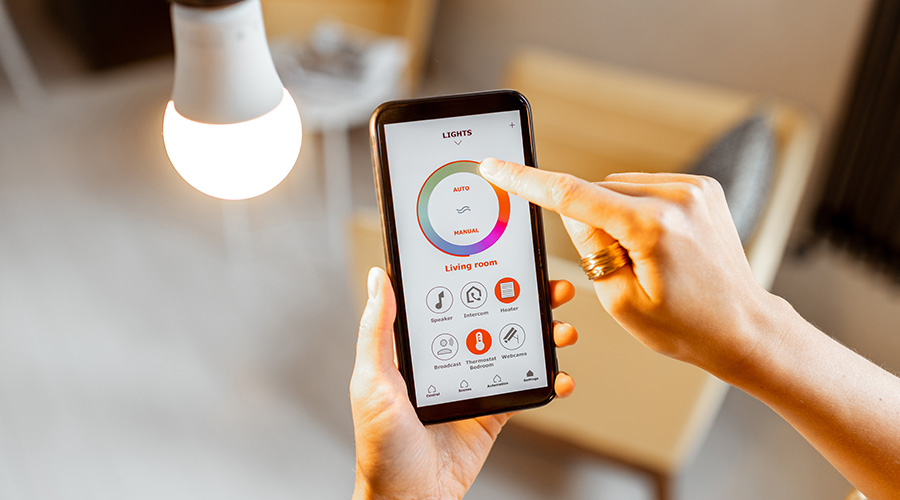New LEDs for Today’s Facilities
Technology advances in LED lighting expand opportunities
for managers seeking greater energy efficiency and lighting quality
Light-emitting diodes (LED) have been around for quite some time. But in recent years, they emerged as viable options for engineering and maintenance managers seeking lighting alternatives for specific applications in facilities. But increasingly, LEDs are moving into more traditional lighting applications and making managers reconsider their views.
Early versions of the LED were very dim and not very efficient in terms of lumens per watt. The need for indicators that lasted longer, were more compact and would respond to indicate simple information drove this technology as an early platform.
As inefficient as the incandescent lamp is, its use continues to grow in many parts of the world. But LEDs have displaced inefficient and short-lived lamps in many applications as both retrofit and new systems. Primarily starting in indicators and similar applications that used miniature and subminiature incandescent lamps, LEDs have sliced through markets quickly.
Facility Opportunities
LEDs, sometimes called solid-state lighting, are different than most light sources in institutional and commercial facilities. They don’t have a fragile filament and glow with electricity being passed through them. They are not a gas discharge or arc lamp like fluorescent or high intensity discharge that emits photons, or light, through the electric arc plasma.
Instead, they are microscopic layers of a variety of materials on a substrate — usually silicon carbide or sapphire — that emit photons when a small electric current passes through the layers. The composition of the layers determines the color of light emitted.
New materials that are both robust and deliver vastly improved efficiency have enabled LED technology to succeed in very tough markets and applications. With significant advances in white LEDs, they also have moved into the cusp of general illumination markets. Although the path through these markets hasn’t been completely smooth, many proven applications exist for LEDs and many promising applications deserve managers' consideration.
Instrumentation has been a major growth platform and uses continue to grow and expand into the electronics and personal device applications. From cell phones, personal digital assistants, digital cameras, instruments and electronics to the latest generation of high-brightness and white-light LEDs, they have expanded the performance of the instruments and provided increased quality.
Signage continues to expand the use of LEDs in both single- and mixed-color LEDs. Large video screens, scoreboards, moving-message signs and directional signals use the expansion of the optical performance, brightness, color and longevity of LED products. The future looks very positive, as this technology interfaces so well with computers and controls.
Exit signs are worth a mention by themselves. Managers who haven’t retrofitted or replaced exit signs with LEDs should do so. With energy usage levels of 2 watts or less, compatibility with battery packs, extremely long life and low cost, they pay for themselves in a matter of months, due to 24 hours a day use. Again, robust performance makes them great solutions for this application.
A note of caution on retrofits is appropriate: Managers must make sure the optics do a sufficient job of illuminating the sign, and watch the applications with high ambient temperatures.
Illumination is the market that will further test the leading-edge performance and costs of LEDs. The top prize in the illumination market is to generate white light through a variety of techniques. Mixing primarily red, blue and green to deliver white light is one way of accomplishing this goal.
New LED materials that deliver blue or ultraviolet energy and use a phosphor is another primary way of achieving white light. The industry trend is to pursue the latter process. White and high-brightness LEDs come with high costs and must meet and beat present light source technologies in order to displace them.
New Markets, New Challenges
LEDs gained much of their early success in the illumination market for display, accent, task, architectural accents and shorter-throw-distance downlighting. They also have done well in applications where low voltage and low heat are beneficial, including pools, spas and fountains.
Not surprisingly, LEDs can add color and animation to many applications, including architectural coves, walls and outdoor uplighting. Managers should look for LEDs to offer longer throw distances and more traditional applications as their lumen output rises and costs continue to decrease.
As with many pioneering products, early versions of white LEDs were nowhere near the 100,000 hours the market expected based upon green, amber and red LEDs. So the market was disappointed, and manufacturers focused on solving issues around the short life of white LEDs.
Generally, manufacturers found two main reasons for short life: thermal degradation and overpowering. Heat causes the LEDs' plastic to break down and interfere with light output. LEDs also drop in light output as their temperature rises. Incorporating this technology into enclosures and fixtures requires a full grasp of these thermal effects to gain maximum performance. Managers should look for the thermal profiles for the LED source or fixture from the manufacturer to avoid these thermal problems.
A gap has existed between integrators and manufacturers who build LED-driven luminaires. But many well-known manufacturers have entered the market in the past year and brought along technology advances.
That shift has helped these applications develop, but there is also the gap related to installers. New technology requires a new set of skills and knowledge of installation requirements. Many early LED failures — especially in warmer ambient areas such as ceilings and plenums and in outdoor applications — resulted from a lack of adequate instruction or failure to follow instructions.
Technicians must following wiring instructions exactly, as there is a greater sensitivity to overdriving LEDs, and managers must be sure that the manufacturer provides adequate instructions and that the installer follows those instructions.
At a lighting industry trade show earlier this year, 46 entries included LEDs in the new product showcase categories, making LEDs one of the most robust, innovative platforms in the industry. But as with any new technology, flaws will arise, and some manufacturers will over-promise.
To succeed, managers must treat LEDs similar to any other lighting products. Ask for specifications, as well as test and performance data, and make sure installers follow installation instructions.
LEDs: How They Compare
How do lighting-emitting-diodes (LED) stack up against current lighting sources? A standard incandescent lamp generates 10-15 lumens per watt with a life of about 1,000 hours. Basically, these lamps are cheap to buy and expensive to operate. Incandescent lamps actually put out much more heat than light; about 90 percent of their energy is heat.
LEDs generate heat as current passes through the chip, but they produce very little heat in the light they emit. The heat that LEDs emit must be dissipated through the proper thermal management design of the LED, the array of LEDs and the enclosure or fixture.
LEDs currently generate about 40 lumens per watt for the newest high-brightness white, with near-term performance targets of 60 lumens per watt. LED life does vary, depending on the type and thermal effects. But the current range is about 20,000 hours for white to 100,000 hours for green and amber.
Fluorescent technology has made significant gains through the use of electronics and miniaturization of compact fluorescent lamps (CFL), which operate in the range of 50-60 lumens per watt. Current higher-wattage lamps operate at 80-100 lumens per watt with excellent color rendering, moderate cost, and low cost to operate.
The goal is to get LEDs into the range of 100 lumens per watt, but until they do that and have 90-plus color rendering, LEDs will not compete much for general illumination. The trend among manufacturers will be to develop efficiencies, reduce costs and pursue this large market. But a related technology called organic light-emitting diodes (OLEDs) might get there sooner for this market.
High-intensity discharge (HID) sources operate in the 60-100 lumens per watt range with a variety of applications, colors and wattages. HID and LEDs overlap very little, since HID sources tend to come in extremely large lumen packages. New ceramic materials with metal halide sources at lower wattages have increased applications for HIDs display, accent and task-illumination applications.
LED manufacturers not only are focusing on but also successfully making the early entries into this area. Incandescent sources, primarily halogen, also are aimed at this part of the market. The battle will continue, but for now the advantage is in ceramic metal halide.
|
Jeff McDonald is president of McDonald Consultants, an independent lighting consulting company in University Heights, Ohio.
Related Topics:











